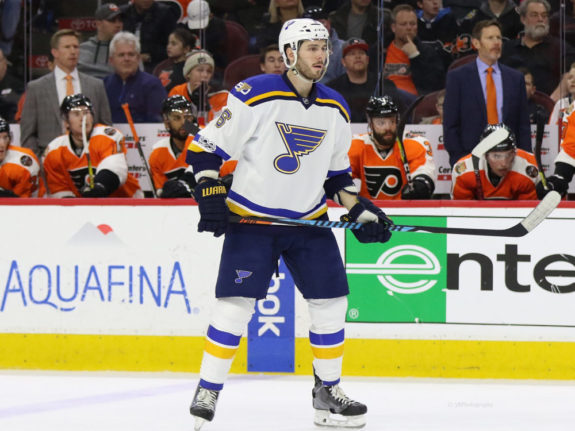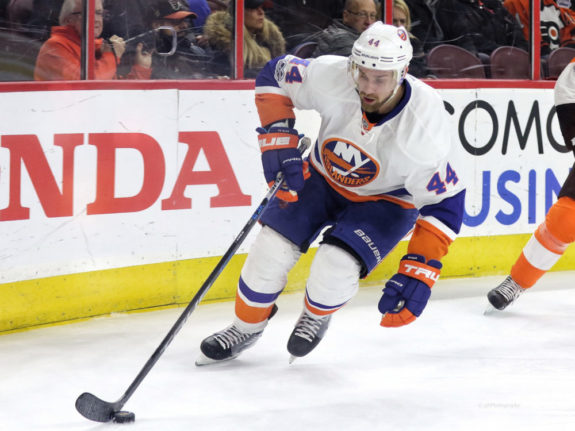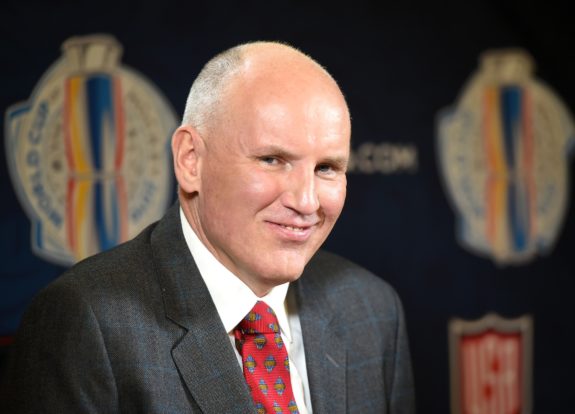The St. Louis Blues have a number of significant contract negotiations coming this offseason, but none is more critical than that with their left-handed defenseman Joel Edmundson. He is a pending restricted free agent (RFA) who is coming off of a one-year, $3 million contract which he signed to assist the team with their salary cap situation.
The cap won’t be a problem in the coming offseason, which means that Edmundson will be looking to get paid. But what should a contract for the lefty look like? It’s a difficult number to pin down, so the following will be a journey of discovery for both writer and reader. Let’s take a look at the numbers.
Edmundson: Top-Pairing Defenseman?
The most significant question the Blues have to answer is whether or not Edmundson is their top-pairing LHD. There is no question that the defender’s camp will answer in the affirmative, but the team may not be so certain. He is currently second amongst Blues’ LHD in minutes, trailing Jay Bouwmeester by just under a minute per game.

Edmundson is also a strong plus-minus performer, registering a plus-six, but Vince Dunn, another lefty defender, narrowly edges him out at plus-seven. He is not known as an offensive force, either, with just 11 points in 60 games, a number that puts him slightly below his career pace. Top pairing defenders in the NHL are usually expected to be two-way contributors, but that is not a role he is able to fill.
There are several things that Edmundson does offer, though. He is the team’s most physical player, leading the group in hits with 124. He is a decent possession player, as well, with a career Corsi for percentage (CF%) of 50.7 percent. It’s an acceptable number, though again, perhaps not strong enough to be a real first-pairing defender. His relative CF% is minus-1.2, which means he is possessing the puck slightly worse than his teammates.
This information, taken as a whole, suggests that Edmundson is a very strong NHL defenseman, and certainly a valuable part of a top-four. But he may not be an ideal fit for a top pairing in the modern game.
The Deeper Metrics
Of course, in today’s day and age, no player should be evaluated by their hockey card stats alone. We’ve already discussed his CF%, which is a point in his favor. He is also improving in that category on the penalty kill, where he is receiving more ice time than he has in previous seasons.
Edmundson is not yet a player the Blues trust on the power play, and he may never be. That points to the lack of offense in his overall game. According to Natural Stat Trick, he has played just nine minutes in that role, most of them coming as a result of “on the fly” starts, which indicates the Blues are turning to him out of convenience or necessity, and not by choice.
Let us consider one more statistical category which will help us narrow in on some of the players (and contracts) who are comparable to Edmundson: point shares. These are stats that are designed to calculate roughly what value a player contributes to his team’s place in the standings. He currently has 5.8 defensive point shares (DPS) and a total point share (PS) of 5.7 (meaning he is actually a minus-0.1 on offense). Let’s take a look at some similar defenders judging on those numbers.
De Haan and Other Comparables
When comparing Edmundson’s point share score to other defenders, one immediate comp jumps out: Calvin de Haan of the Carolina Hurricanes. Like Edmundson, de Haan is a left-handed defender without a lot of offensive upside, and his PS is 5.7, just a tenth of a point higher. Edmundson is the larger of the two players, but de Haan delivers more hits and generates more takeaways, as well. They both log similar minutes, between 18 and 20 minutes per game.

Conveniently for our purposes, de Haan just signed a contract this past offseason, one valued at four years, $18.2 million, with an average annual value (AAV) of $4.55 million. That is a valuable contract comparison for us, and one that will likely come up during Edmundson’s contract negotiations. But de Haan isn’t the only defender in Edmundson’s PS range.
Troy Stecher, who is a young defensive leader with the Vancouver Canucks, also has a 5.6 PS this season. He is a little younger than Edmundson and just signed a two-year contract with an AAV of $2.325 million. Matt Grzelyck of the Boston Bruins also just signed an two-year extension, with an AAV of $1.4 million, but he is also a bit younger than the Blues’ pending-RFA.
Finally, there is Hampus Lindholm of the Anaheim Ducks. He is a more valuable player offensively than Edmundson, but not by a massive margin. His total PS is 5.8, but his DPS is 4.8, lower than that of the Blues’ defenseman. He signed a six-year, $31.5 million contract extension early in the 2016-17 season, though at the time, he was coming off a much better season with a PS of 7.3. He is a good comparable for what might be the high-end of Edmundson’s deal.
“St. Louis Inks Edmundson For…”
Now, to the final conclusions. Of the comparables considered above, de Haan is clearly the closest to Edmundson, so his four-year, $18.2 million contract is a good place to start. There are several more things to consider, though, some that help his case and some that hurt it.
Joel Edmundson is one of the #stlblues best players, not just Dmen, will impact team more than some might realize. Defends, hard to play against, great first pass, sneaky good in O-Zone, gets pucks thru, settle down game in own end
— Andy Strickland (@andystrickland) October 7, 2018
First, Edmundson may perceive that he’s done the Blues a favor by signing a one-year deal this season and may expect to be paid accordingly. Second, he will make the case that he is the Blues’ most valuable LHD, and therefore ought to be paid as a top-pairing blueliner.
On the other hand, his ceiling is limited somewhat by two factors, as well. First, he is signing as an RFA, meaning he will not have the benefit of the open market to drive his price up. Second, he is teammates with Colton Parayko, who is on one of the more team-friendly contracts in the league. After this season, there will be three more years on Parayko’s deal at $5.5 million per season. It is difficult to imagine Edmundson surpassing that cap hit, as Parayko leads the NHL in DPS this season.
With all of that in mind, a three or four-year contract extension seems most likely for Edmundson. General manager Doug Armstrong has shown a tendency in the past to avoid lining up too many expiring deals in the same season, so extending him beyond Parayko at four years seems likely. Now, for cap hit, I would expect him to make more per season than de Haan, but less than Parayko, which would put him in the $5 million range.

So there you have it: Edmundson will sign a four-year contract with an AAV of $5 million in the offseason. Of course, NHL contracts are rarely that clean, but that seems to be the right neighborhood for both parties involved. The defender’s camp can argue that they are being paid as the team’s top LHD, while the Blues maintain some flexibility on the years and the cap hit. It would be a good deal for both sides, one that would help shape the defensive core for the future.